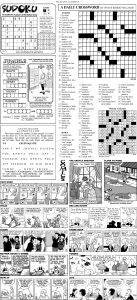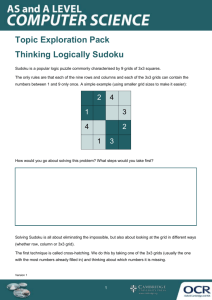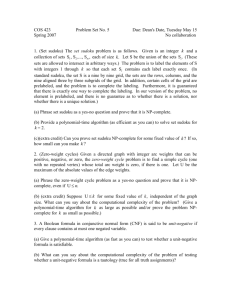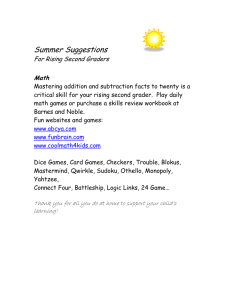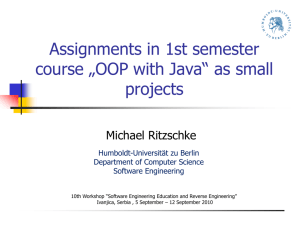2014MidtermExam-key - Rose
advertisement
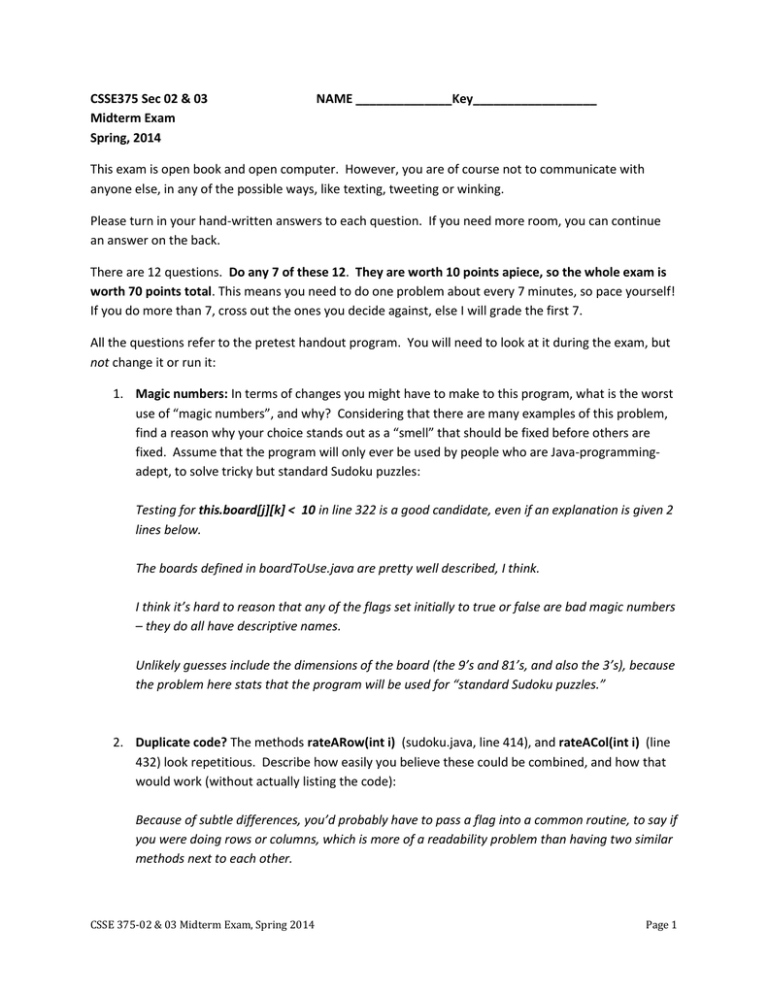
CSSE375 Sec 02 & 03 Midterm Exam Spring, 2014 NAME ______________Key__________________ This exam is open book and open computer. However, you are of course not to communicate with anyone else, in any of the possible ways, like texting, tweeting or winking. Please turn in your hand-written answers to each question. If you need more room, you can continue an answer on the back. There are 12 questions. Do any 7 of these 12. They are worth 10 points apiece, so the whole exam is worth 70 points total. This means you need to do one problem about every 7 minutes, so pace yourself! If you do more than 7, cross out the ones you decide against, else I will grade the first 7. All the questions refer to the pretest handout program. You will need to look at it during the exam, but not change it or run it: 1. Magic numbers: In terms of changes you might have to make to this program, what is the worst use of “magic numbers”, and why? Considering that there are many examples of this problem, find a reason why your choice stands out as a “smell” that should be fixed before others are fixed. Assume that the program will only ever be used by people who are Java-programmingadept, to solve tricky but standard Sudoku puzzles: Testing for this.board[j][k] < 10 in line 322 is a good candidate, even if an explanation is given 2 lines below. The boards defined in boardToUse.java are pretty well described, I think. I think it’s hard to reason that any of the flags set initially to true or false are bad magic numbers – they do all have descriptive names. Unlikely guesses include the dimensions of the board (the 9’s and 81’s, and also the 3’s), because the problem here stats that the program will be used for “standard Sudoku puzzles.” 2. Duplicate code? The methods rateARow(int i) (sudoku.java, line 414), and rateACol(int i) (line 432) look repetitious. Describe how easily you believe these could be combined, and how that would work (without actually listing the code): Because of subtle differences, you’d probably have to pass a flag into a common routine, to say if you were doing rows or columns, which is more of a readability problem than having two similar methods next to each other. CSSE 375-02 & 03 Midterm Exam, Spring 2014 Page 1 A likely choice, however, would be to make the identical code, everything inside the outside “for” loop, be an internally called method in the class. You would only have to pass I and j to it, and return null (as the two methods are written now). 3. Big refactoring, part 1: Suppose you were going to turn this program into a real OO program. What would you do first, following Fowler’s recommendations? Describe the process you would use, in terms of this particular program: Fowler says you would first analyze the data, and then start data-only classes with the data that looked to be related in each. For example, there might be a class for the game board, to which you would later add methods about the board. The rest of the process includes, mostly, moving code that goes with the data used to start classes, surely stopping to fix dependency problems as these occur. 4. Big refactoring, part 2: In making this into an OO program, draw a class diagram picture showing the 5 or 6 main app classes you would create (ignoring the problem of making a UI for it). You do not need to show attributes or methods. Do show, using labeled arrows between them, how these classes’ main interactions would work, and explain those in words: This is basically just a game, and could be constructed something like the following. Alternative designs also would work, of course! In this design, the Strategy’s are handled by a subclassing scheme, to simplify the logic. The Game has main and creates the board, possibly multiple times. Board is populated for a single run, and creates a strategy object to go with that run. Game then does the recursive search to solve each game, and prints the results. CSSE 375-02 & 03 Midterm Exam, Spring 2014 Page 2 5. Doing too much? The method checkValues(int next_i, int next_j, int myValue), (Sudoku.java, starting at line 736), is an example of a method that does multiple actions. How, in general, would you turn it into something easier to understand? The separate actions are the 3 “for” loops, which could be called as internal methods to the class, with names like checkTheRow, checkTheColumn, and checkTheSquare. 6. Doing everything! Considering the very long and messy method depthFirst(int bop) in particular (line 633 of sudoku.java), describe generally how you would break-up this method to achieve a better separation of concerns: Subclassing the strategies, as shown in the answer to question 4, has the greatest promise. This gets rid of some of the logic in depthFirst. However, the conditions change, in the if / else tests, so subclassing is not the full answer. Much of the logic may have to be broken-up logically by calling internal methods to the class. Even simple tests, like the logic starting with if (this.cycles % 1000000 == 0) in line 641 could be made into a method call like checkRunaway(bop). CSSE 375-02 & 03 Midterm Exam, Spring 2014 Page 3 7. Data representation: The program’s author wanted to call recursively the depth-first search depthFirst(int bop) (line 633 of sudoku.java), without creating a new board for each such call. He realized that, in backtracking from those calls, choices made earlier could be undone. However, it was important not to “undo” a number which had been placed as an original part of the given problem. Thus, those original numbers from the problem were shown as values 1 – 9 in a square on the board. Values that the program tried to pick, in its solving of the puzzle, had “10” added to them. E.g., if the program sees a “7” in a square, it knows that was given as part of the original problem. If it sees a “17”, it knows that this also is just 7, but an earlier iteration of the search put that 7 there; it could be undone as a choice during backtracking. There probably are simpler ways to do this coded representation. But, is it worth refactoring the program to make a clearer scheme for this? Why or why not? This method is referred to 17 times in different parts of sudoku.java, so changing the scheme would need to be done carefully throughout all that code. This error-prone refactoring should be done only if there were a good reason to change it, beyond what’s described in this test problem. 8. Dealing with growth: Suppose you had the idea to add a bunch more strategies for the search. In what way would you want to refactor the program to allow for that (give some line numbers to be specific), and why? Definitely subclass some strategy family, as already noted, so that you could eliminate the if’s in the constructor (which starts on line 52) or at least move them to subclasses, and avoid all those strategy-related conditionals in depthFirst (starting on line 633). Then you just add another subclass for each of the new strategies and call it as another thing to try. 9. Changing the architecture: Suppose you wanted to speed up the program’s runtime, by having the program try different strategies on the 8 different processors on your laptop, all running simultaneously. Any strategy finding “the answer” would report back that success, and they would then all quit. Without explicitly describing how you would do this, is it feasible without changing a lot of code? Why or why not? It’s not that bad, because “main” creates an instance of “sudoku”. Each such instance could then be “run” on a separate processor. The first to finish would return to main when done. It would then cancel the list of all the others and print the result from the one that completed. CSSE 375-02 & 03 Midterm Exam, Spring 2014 Page 4 10. More duplicate code: The code in the constructor sudoku() (line 52 of sudoku.java) has a series of long “if” statements which look suspiciously similar. Describe how you would “clean these up” to remove duplicate code: Also cleaned up by subclassing the search methods. However, one would want to look at the very similar code in each of those “if” statements, to try to find an alternative to just writing almost duplicate code in each strategy subclass. It’s still going to be a mess of code in each subclass. Careful analysis, however, reveals that all the flag setting, for each strategy, amounts to setting everything false except the desired flag. They could ALL be set false in a common routine, and then only the desired one set true in each subclass, for initialization. 11. Debugging code: The program includes a lot of test code, like scrambleBoardOrder(int howManyTimes), (line 480 of Sudoku.java), and debug print lines (like the commented-out line 476 of sudoku.java). What would be a better strategy for inclusion of this debugging code, and why? One could use Mock versions of some routines, which had debugging code in them. Or, subclass to call debugging versions. There may be no clean solution for this, for things like debug print lines. 12. Getting rid of a local variable: In checkValues(int next_i, int next_j, int myValue), (Sudoku.java, starting at line 736), we see that boardValue = this.board[i][next_j] is defined as a local variable, to check to see if a numeric value is already used in a row, etc. We could instead have avoided defining a local variable here, and used what it’s equal to throughout this method. Describe why one of these two choices is better, in this case: Probably you are stuck with the current way of handling boardValue. The problem is that this value is changed in line 741, with boardValue=boardValue+10. Further replacements of boardValue with a fresh call to get its original value would be wrong. CSSE 375-02 & 03 Midterm Exam, Spring 2014 Page 5
